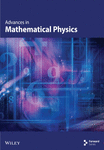Eigenvalue Localization Inequalities for Complex Matrices With Order n ≥ 3
Abstract
In this paper, we obtain some eigenvalue location inequalities for complex matrices with order n(n ≥ 3).
MSC2020 Classification: 15A18, 15A60, 15A42
1. Introduction
Let Mn be the space of complex matrices. For A ∈ Mn, A∗ is the conjugate transpose matrix of A, λ1, λ2, …, λn are the eigenvalues of A repeated according to their algebraic multiplicities and is the Frobenius norm. and .
Next, Ostrowski has made improvements on this [2]. Brauer used Cassini ovals to determine inclusion regions of any n × n complex matrix’s eigenvalues [1]. Fan [3] obtained an inequality that is similar to Geršchgorin’s.
In [4–15], the authors used the union of some subsets (small disks, ovals, or other domains) to determine the location of eigenvalues.
Specially, motivated by Rojo’s work in [9], in [15], Wu and Zhao proved that
Theorem 1. Let A ∈ Mn with eigenvalue λ. Then,
An application of Theorem 1 is as follows:
Theorem 2. Let A ∈ Mn with eigenvalues λ1, λ2, …, λn. Then, all its eigenvalues are lie in the elliptic region
As Wu and Zhao stated in [15], such an elliptic region is the best one.
Matrix eigenvalues are widely used in quantum mechanics (see [16–21] for more details). Therefore, studying the estimation of matrix eigenvalues is meaningful in physics. For the eigenvalues of a 2 × 2 matrix, their range could be considered by direct calculations. Therefore, mathematicians always consider the order of the matrix is greater than 2 for better applications. After reading [15], our concern is whether stronger versions of inequality (Equation (2)) and equality (Equation (3)) could be found for n ≥ 3. This is the motivation for studying this paper. In this paper, we give some refinements of inequalities (Equations (1) and (2)) and equality (Equation (3)).
2. Main Results
We start our work with the following auxiliary lemmas. Throughout the paper, we write Sℓ to present the set {1, 2, …, n}∖{ℓ} for ℓ = 1, 2, …, n..
Lemma 1 see [14]. Let zi(1 ≤ i ≤ n) be complex numbers with n ≥ 3. Then,
Lemma 2 see [22]. Let A ∈ Mn with eigenvalue λi(1 ≤ i ≤ n). Then,
Lemma 3 see [14]. Let z1, z2, …, zn be complex numbers. Then,
From the above lemmas, we conclude our first result.
Theorem 3. Let A ∈ Mn(n ≥ 3) with eigenvalue λℓ. Then,
Proof. Let λℓ be an arbitrary eigenvalue of A. By equality (Equation (4)), we have the following:
Corollary 1. Let A ∈ Mn(n ≥ 3) with eigenvalue λℓ. Then,
The next result is a consequence of Theorem 3.
Theorem 4. Let A ∈ Mn with eigenvalues λ1, λ2, …, λn(n ≥ 3). Then, all eigenvalues are located in elliptic region
Proof. We first consider the case tr(A) = 0. It follows from Theorem 3 that
Therefore, the desired result is obtained.
Conflicts of Interest
The authors declare no conflicts of interest.
Funding
This work is supported by the National Research Project Incubation Foundation of Southeast University Chengxian College (2022NCF008) and the Young Teachers’ Research and Development Fund of Southeast University Chengxian College (z0058).
Open Research
Data Availability Statement
Data sharing is not applicable to this manuscript as no new data were created or analyzed in this study.




